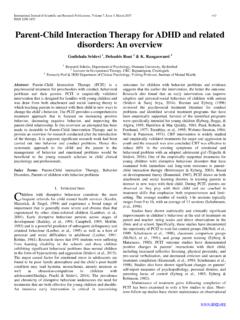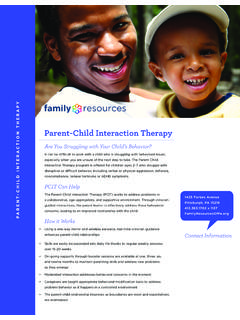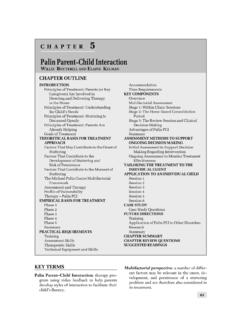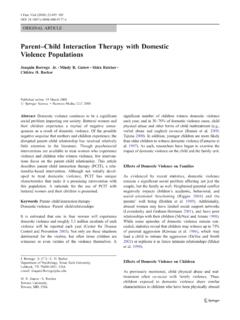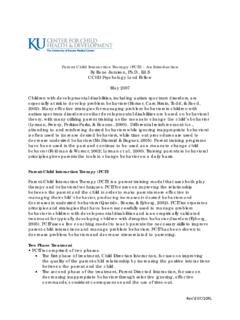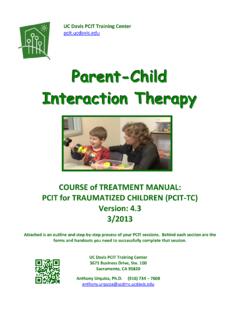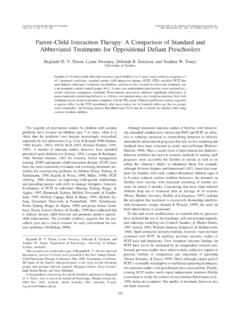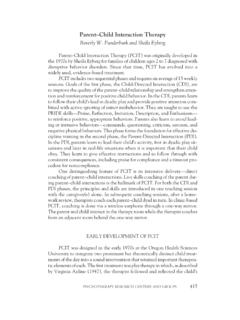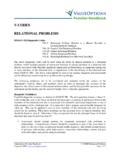Transcription of Parent-Child Interaction Therapy With At-Risk Families
1 child Welfare Information GatewayChildren s Bureau/ACYF1250 Maryland Avenue, SWEighth FloorWashington, DC : BRIEFJ anuary 2013 Use your smartphone to access this issue brief Interaction Therapy With At-Risk FamiliesWhat s Inside: What makes PCIT unique? Key components Effectiveness of PCIT Implementation in a child welfare setting Resources for further informationParent- child Interaction Therapy (PCIT) is a family-centered treatment approach proven effective for abused and At-Risk children ages 2 to 8 and their caregivers birth parents , adoptive parents , or foster or kin caregivers. During PCIT, therapists coach parents while they interact with their children, teaching caregivers strategies that will promote positive behaviors in children who have disruptive or externalizing behavior problems. Research has shown that, as a result of PCIT, parents learn more effective parenting techniques, the behavior problems of children decrease, and the quality of the Parent-Child relationship Interaction Therapy With At-Risk material may be freely reproduced and distributed.
2 However, when doing so, please credit child Welfare Information Gateway. Available online at issue brief is intended to build a better understanding of the characteristics and benefits of PCIT. It was written primarily to help child welfare caseworkers and other professionals who work with At-Risk Families make more informed decisions about when to refer parents and caregivers, along with their children, to PCIT programs. This information may also help parents , foster parents , and other caregivers understand what they and their children can gain from PCIT and what to expect during treatment. This brief also may be useful to others with an interest in implementing or participating in effective parent-training Makes PCIT Unique?Introduced in the 1970s as a way to treat young children with serious behavioral problems, PCIT has since been adapted successfully for use with populations who have experienced trauma due to child abuse or neglect.
3 The distinctiveness of this approach lies in the use of live coaching and the treatment of both parent and child together. PCIT is the only evidence-based practice in which the parent and child are treated together throughout the course of all treatment sessions. As a result, it is a more intensive parenting intervention and most applicable for children with serious behavioral problems, parents with significant limitations ( , substance abuse, limited intellectual ability, mental health problems), and/or parents at risk for child maltreatment. In randomized testing, including Families identified by the child welfare system, PCIT has consistently demonstrated success in improving Parent-Child interactions . Benefits of the model, which have been experienced by Families along the child welfare continuum, such as At-Risk Families and those with confirmed reports of maltreatment or neglect, are described below.
4 Parent-Child Interaction Therapy is one of the most effective evidence-based practices in the field today. Using an in vivo training technique, parents acquire more effective parenting skills, children s behavioral problems improve, and together they develop a more positive and affectionate relationship. The positive affiliative nature developed as a result of participation in PCIT strengthens attachment and builds resilience in At-Risk Families . Anthony Urquiza, , Director of Mental Health Services and Clinical Research at the University of California at Davis CAARE CenterReduces Behavior Problems in Young Children by Improving Parent-Child InteractionPCIT was originally designed to treat children ages 2 to 8 with disruptive or externalizing behavior problems, including conduct and oppositional defiant disorders. These children are often described as negative, argumentative, disobedient, and addresses the negative Parent-Child Interaction patterns that contribute to the disruptive behavior of young children (Bell & Eyberg, 2002).
5 Through PCIT, parents learn to bond with their children and develop more effective parenting styles that better meet their children s needs. For example, parents learn to model and reinforce constructive Parent-Child Interaction Therapy With At-Risk Families3 This material may be freely reproduced and distributed. However, when doing so, please credit child Welfare Information Gateway. Available online at for dealing with emotions, such as frustration. Children, in turn, respond to these healthier relationships and interactions . As a result, children treated using PCIT typically show significant reductions in behavior problems at home and at school (Brinkmeyer & Eyberg, 2003; Gallagher, 2003; McNeil, Eyberg, Eisenstatdt, Newcomb, & Funderburk, 1991; McNeil & Hembree-Kigin, 2010; Nixon, Sweeney, Erickson, & Touyz, 2003; Schuhmann, Foote, Eyberg, Boggs, & Algina, 1998).
6 Treats the Parent and child Together While many treatment approaches target either parents or children, PCIT focuses on changing the behaviors of both the parent and child together. parents learn to model positive behaviors that children can learn from and are trained to act as agents of change for their children s behavioral or emotional difficulties (Herschell & McNeil, 2005). Sitting behind a one-way mirror and coaching the parent through an ear bug audio device, therapists guide parents through strategies that reinforce their children s positive behavior. In addition, PCIT therapists are able to tailor treatment based on observations of Parent-Child interactions . As such, PCIT can help address specific needs of each parent and the Risk for child Physical Abuse and Breaks the Coercive Cycle PCIT has been found effective for physically abusive parents with children ages 2 to 12 (Borrego, Urquiza, Rasmussen, & Zebell, 1999; Chaffin et al.)
7 , 2004; Chaffin et al., 2009; Hakman, Chaffin, Funderburk, & Silovsky, 2009; Chaffin, Funderburk, Bard, Valle, & Gurwitch, 2011). PCIT is appropriate where physical abuse occurs within the context of child discipline, as most physical abuse does. While child behavior problems and child physical abuse often co-occur, PCIT may help change the parental response to challenging child behaviors, regardless of the type of behavior problem. Foundational research has shown that many complex factors contribute to abusive behaviors, including a coercive relationship between the parent and child (Fisher & Kane, 1998; Urquiza & McNeil, 1996). Abusive and At-Risk parents often interact in negative ways with their children, use ineffective and inconsistent discipline strategies, and rely too much on punishment. These same parents rarely interact in positive ways with their children ( , rewarding good behavior).
8 At the same time, some physically abused and At-Risk children learn to be aggressive, defiant, noncompliant, and resistant to parental direction (Kandel, 1992; Larzelere, 1986). The reciprocal negative behaviors of the parent and child create a harmful cycle that often escalates to the point of severe corporal punishment and physical abuse. The negative behaviors of the parent screaming and threatening reinforce the negative behaviors of the child such as unresponsiveness and disobedience, which further aggravates the parent s behavior and may result in violence. PCIT helps break this cycle by encouraging positive Interaction between parent and child and training parents in how to implement consistent and nonviolent discipline techniques when children act and caretakers completing PCIT typically: Show more positive parenting attitudes and demonstrate improvements in the ways that they listen to, talk to, and interact with their children (McNeil & Hembree-Kigin, 2010) Parent-Child Interaction Therapy With At-Risk material may be freely reproduced and distributed.
9 However, when doing so, please credit child Welfare Information Gateway. Available online at Report less stress (Timmer, Urquiza, Zebell, & McGrath, 2005) Use less corporal punishment and physically coercive means to control their children (Chaffin et al., 2011)In addition, parent satisfaction with PCIT is typically high (Chaffin et al., 2004).Offers Support for Caregivers Including Foster ParentsPCIT is now recognized as a way to help support foster parents caring for children with behavioral problems by enhancing the relationship between foster parents and foster children and by teaching foster parents behavior management skills. In addition to reporting decreases in child behavior problems, foster parents frequently report less parental stress following PCIT and high levels of satisfaction with the program (McNeil, Herschell, Gurwitch, & Clemens-Mowrer, 2005; Timmer, Urquiza, & Zebell, 2005).
10 One benefit of providing foster parents with PCIT skills is that they can use these same effective parenting skills with future generations of foster Live CoachingPCIT is a behavioral parent-training model. What makes PCIT different from other parent training programs is the way skills are taught, using live coaching of parents and children together. Live coaching provides immediate prompts to parents while they interact with their children. During the course of this hands-on treatment, parents are guided to demonstrate specific relationship-building and discipline benefits of live coaching are significant: parents are provided with opportunities to practice newly taught skills. Therapists can correct errors and misunderstandings on the spot. parents receive immediate feedback. parents are offered support, guidance, and encouragement as they learn. Treatment gains ( , increases in child compliance) are recognized by the parent in the moment which supports continued use of effective parenting is currently underway to determine if PCIT training can be administered via the Internet with Remote Real-Time (RRT) training.










